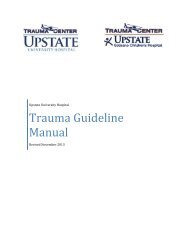10 Alumni Journal - SUNY Upstate Medical University
10 Alumni Journal - SUNY Upstate Medical University
10 Alumni Journal - SUNY Upstate Medical University
You also want an ePaper? Increase the reach of your titles
YUMPU automatically turns print PDFs into web optimized ePapers that Google loves.
Room with a View<br />
High-tech video equipment transforms the process of learning gross anatomy.<br />
Fans of early James Bond films may<br />
recall that Bond’s first villain, Dr. No,<br />
survived a gun shot wound to the left<br />
chest because of the unique medical<br />
condition situs inversus, in which all<br />
major visceral organs are reversed or<br />
mirrored from their normal positions.<br />
(The heart, for example, is located to<br />
the right of the thorax instead of the left.)<br />
As this condition occurs in only one<br />
of 22,000 people, it was a unique learning<br />
opportunity when a cadaver with the condition<br />
was discovered in gross anatomy class.<br />
“It was an 87-year-old man who had<br />
fallen off a ladder, so in addition to the situs<br />
inversus, he had a blood clot on the brain<br />
and a broken shoulder. It was a great learning<br />
case,” says N. Barry Berg, PhD, who directs<br />
the <strong>Upstate</strong> anatomy program.<br />
The learning opportunity may have<br />
ended with that group of students had it<br />
not been for the addition of high-definition<br />
video equipment to the lab. The ability<br />
to film the dissection of the situs inversus<br />
“patient” in high definition and show it<br />
on multiple large screens throughout the<br />
lab, preserves the case for future classes of<br />
medical students to come.<br />
“Every person’s body has some variation<br />
and we want the students to understand<br />
that,” says Joseph W. Sanger, PhD, chair of<br />
the Department of Cell and Developmental<br />
Biology. “One in 1,200 people are walking<br />
around with just one kidney. With this<br />
type of camera, we can record the interesting<br />
variations to reinforce this concept<br />
to students.”<br />
If a student discovers something unusual<br />
or interesting in their cadaver, “we can bring<br />
it over to the camera area and display it on<br />
the monitors throughout the lab so that<br />
all students can get a good look and ask<br />
questions. It makes the class much more<br />
interactive,” says Dan Jaeger, laboratory<br />
director. “In addition, the films are saved<br />
for future use.”<br />
While the opportunity to save unique<br />
cases for future generations of students is<br />
undoubtedly valuable, the principle benefit<br />
of this technology is the assistance it provides<br />
in teaching gross anatomy by providing visual<br />
guidance to the students during dissection. A<br />
high-definition video camera and six large flatscreen<br />
monitors placed strategically around<br />
the lab allow the instructor to demonstrate<br />
the dissection of a specific body part while<br />
student groups observe that demonstration<br />
from their own station with their own cadaver.<br />
Instead of having 140 students attempting to<br />
crowd around the instructor and cadaver, the<br />
students are able to watch the demonstration<br />
live on-screen while examining the same body<br />
part on their own cadaver.<br />
“The new system allows every student<br />
to experience one-on-one instruction and<br />
provides the entire class with an ideal viewing<br />
angle and great detail on small structures,”<br />
says first-year medical student Giancarlo<br />
Rondash, who was named one of the top<br />
dissectors in Gross Anatomy last fall.<br />
In the past, students would be given general<br />
instruction and a manual describing the<br />
procedure, and faculty would rotate among<br />
the students offering assistance. With 140<br />
students, that can take awhile. “Instead of<br />
taking three days for a dissection because we<br />
have to go from group to group, the instruction<br />
can be done in half an hour,” says Dr.<br />
Berg, providing better use of time because<br />
students have a better understanding of what<br />
they’re doing.<br />
“Before the students dissect the heart,<br />
for example, we play the video of the heart<br />
dissection on the screen, demonstrating what<br />
to look for. Then we stop and let them begin<br />
the dissection and the faculty and TAs are<br />
there to help them. Then we stop, show<br />
them the next step, and let them continue,”<br />
he explains. “They know what to look for.”<br />
After the dissection, the filmed demonstration<br />
is placed on Blackboard, an<br />
e-learning site that houses lecture notes and<br />
other course materials, so students have it to<br />
refer to after hours.<br />
12 A l U M n i J o U r n A l / s P r i n g 2 0 1 0

















